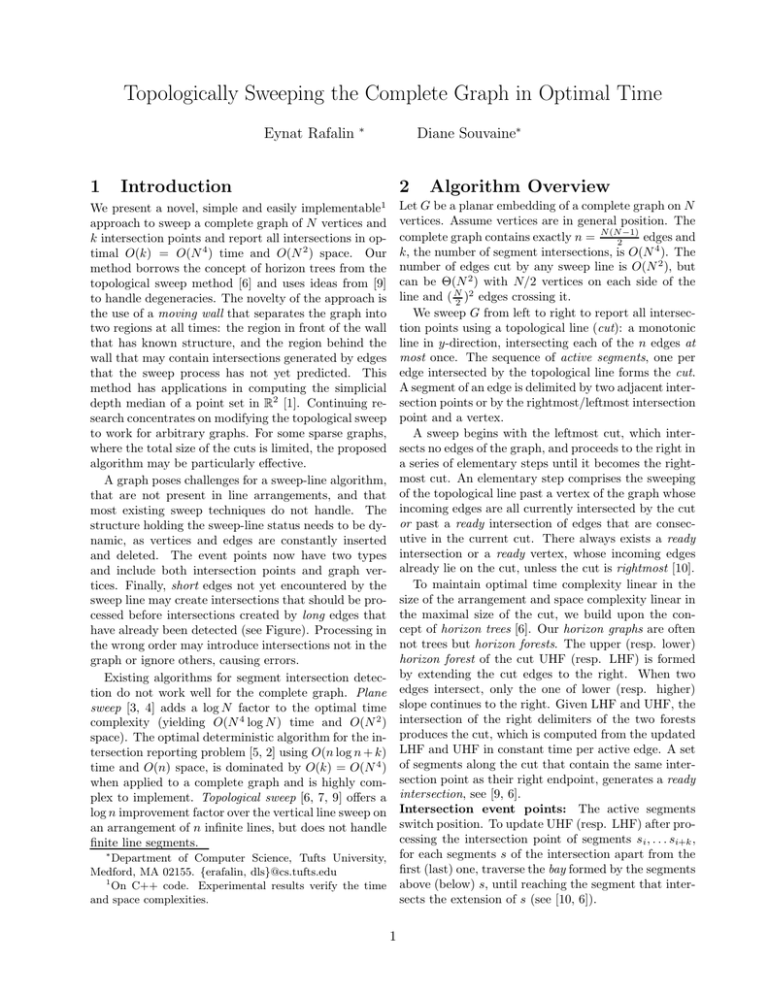Topologically Sweeping the Complete Graph in Optimal Time 1 Introduction 2
advertisement

Topologically Sweeping the Complete Graph in Optimal Time
Eynat Rafalin
1
Diane Souvaine∗
∗
2
Introduction
Algorithm Overview
Let G be a planar embedding of a complete graph on N
vertices. Assume vertices are in general position. The
complete graph contains exactly n = N (N2−1) edges and
k, the number of segment intersections, is O(N 4 ). The
number of edges cut by any sweep line is O(N 2 ), but
can be Θ(N 2 ) with N/2 vertices on each side of the
line and ( N2 )2 edges crossing it.
We sweep G from left to right to report all intersection points using a topological line (cut): a monotonic
line in y-direction, intersecting each of the n edges at
most once. The sequence of active segments, one per
edge intersected by the topological line forms the cut.
A segment of an edge is delimited by two adjacent intersection points or by the rightmost/leftmost intersection
point and a vertex.
A sweep begins with the leftmost cut, which intersects no edges of the graph, and proceeds to the right in
a series of elementary steps until it becomes the rightmost cut. An elementary step comprises the sweeping
of the topological line past a vertex of the graph whose
incoming edges are all currently intersected by the cut
or past a ready intersection of edges that are consecutive in the current cut. There always exists a ready
intersection or a ready vertex, whose incoming edges
already lie on the cut, unless the cut is rightmost [10].
To maintain optimal time complexity linear in the
size of the arrangement and space complexity linear in
the maximal size of the cut, we build upon the concept of horizon trees [6]. Our horizon graphs are often
not trees but horizon forests. The upper (resp. lower)
horizon forest of the cut UHF (resp. LHF) is formed
by extending the cut edges to the right. When two
edges intersect, only the one of lower (resp. higher)
slope continues to the right. Given LHF and UHF, the
intersection of the right delimiters of the two forests
produces the cut, which is computed from the updated
LHF and UHF in constant time per active edge. A set
of segments along the cut that contain the same intersection point as their right endpoint, generates a ready
intersection, see [9, 6].
Intersection event points: The active segments
switch position. To update UHF (resp. LHF) after processing the intersection point of segments si , . . . si+k ,
for each segments s of the intersection apart from the
first (last) one, traverse the bay formed by the segments
above (below) s, until reaching the segment that intersects the extension of s (see [10, 6]).
1
We present a novel, simple and easily implementable
approach to sweep a complete graph of N vertices and
k intersection points and report all intersections in optimal O(k) = O(N 4 ) time and O(N 2 ) space. Our
method borrows the concept of horizon trees from the
topological sweep method [6] and uses ideas from [9]
to handle degeneracies. The novelty of the approach is
the use of a moving wall that separates the graph into
two regions at all times: the region in front of the wall
that has known structure, and the region behind the
wall that may contain intersections generated by edges
that the sweep process has not yet predicted. This
method has applications in computing the simplicial
depth median of a point set in R2 [1]. Continuing research concentrates on modifying the topological sweep
to work for arbitrary graphs. For some sparse graphs,
where the total size of the cuts is limited, the proposed
algorithm may be particularly effective.
A graph poses challenges for a sweep-line algorithm,
that are not present in line arrangements, and that
most existing sweep techniques do not handle. The
structure holding the sweep-line status needs to be dynamic, as vertices and edges are constantly inserted
and deleted. The event points now have two types
and include both intersection points and graph vertices. Finally, short edges not yet encountered by the
sweep line may create intersections that should be processed before intersections created by long edges that
have already been detected (see Figure). Processing in
the wrong order may introduce intersections not in the
graph or ignore others, causing errors.
Existing algorithms for segment intersection detection do not work well for the complete graph. Plane
sweep [3, 4] adds a log N factor to the optimal time
complexity (yielding O(N 4 log N ) time and O(N 2 )
space). The optimal deterministic algorithm for the intersection reporting problem [5, 2] using O(n log n + k)
time and O(n) space, is dominated by O(k) = O(N 4 )
when applied to a complete graph and is highly complex to implement. Topological sweep [6, 7, 9] offers a
log n improvement factor over the vertical line sweep on
an arrangement of n infinite lines, but does not handle
finite line segments.
∗
Department of Computer Science, Tufts University,
Medford, MA 02155. {erafalin, dls}@cs.tufts.edu
1
On C++ code. Experimental results verify the time
and space complexities.
1
Vertex event points: The sweep processes the vertices of the graph only when no intersection points are
ready and in a left-to-right order, precisely when all the
vertices’ incoming edges are active: In a vertex event
point all of the incoming active edges for vertex v are
deleted from the set of active segments and all its outgoing edges are inserted. To update the horizon forests
delete in-edges of v and insert its out-edges. Then update the horizon forest, walking in counterclockwise order around the bay formed by the previous edges to find
the intersection point with an active edge. The edges
emanating from the new vertex to the right, added to
the set of active edges, may cut some of the existing active segments, and change the horizon forests and the
cut. To update the horizon forests, test every existing
forest edge for intersection with the new segment, in
time linear in the size of the cut.
A moving wall: The set of active edges does not span
the whole arrangement. Consequently, the sweep can
encounter intersection points created by active edges
before identifying intermediary edges that block them.
For example, Figure (a) contains a graph of 7 vertices.
The dotted sweep line produces the bold active segments. Intersection B of 06 and 25 is ready to be
processed, as it is the right endpoint of the active segments associated with these edges. B, however, cannot be processed yet, as 06 and 25 intersect 34 before
point B. Furthermore, if intersection B is processed,
06 and 25 will switch position in the cut, causing 34
to be inserted incorrectly. Intersection points that are
to the right of any edge that is not yet active cannot be
ready. Alternatively, consider intersection A. Given
the dotted sweep line, both this intersection and vertex
3 are ready to be processed (in vertical sweep vertex
3 would be processed prior to A). However, the order
of the cut edges currently places the edge 16 over edge
05. If vertex 3 is processed at this time, the update of
the horizon forests and the cut will be5 incorrect. All
intersection points that are to the left of all segments
emanating from vertex v must be processed before v is
processed.
the moving wall (by processing a ready vertex only if it
is to the left of the line defining the wall). Provably, a
ready intersection always exists unless the sweep line is
aligned with the moving wall or has reached the rightmost cut. To align the sweep line with the cut ensure
that no intersection that is inside the wall is ready and
that ready intersections that affect the wall are swept
before the next vertex is processed.
There may be intersections inside the moving wall
associated with vx that can still be legally swept (e.g.
intersection B in Figure (b)). The sweep line is forced
only to the wall formed by the two extreme segments
emanating to the right from vx and their extension to
infinity instead of including all legal ready intersections,
so intersections that are ready but inside the moving
wall are discarded (Figure (b)). These intersections are
rediscovered when vx is swept, by checking every pair
of adjacent active segments in the cut for ready intersections. This step is performed once for each vertex,
with a cost linear in the size of the active set.
Acknowledgment The authors wish to thank Prof.
Ileana Streinu, Michael A. Burr and Ryan Coleman.
References
[1] G. Aloupis, S. Langerman, M. Soss, and G. Toussaint. Algorithms for bivariate medians and a
Fermat-Torricelli problem for lines. Comp. Geom.
Theory and Appl., 26(1):69–79, 2003.
[2] I. J. Balaban. An optimal algorithm for finding
segment intersections. In Proc. 11th Annu. ACM
Sympos. Comput. Geom., pages 211–219, 1995.
[3] J. L. Bentley and T. A. Ottmann. Algorithms for
reporting and counting geometric intersections.
IEEE Trans. Comput., C-28(9):643–647, 1979.
[4] K. Q. Brown. Comments on “Algorithms for
reporting and counting geometric intersections”.
IEEE Trans. Comput., C-30:147–148, 1981.
[5] B. Chazelle and H. Edelsbrunner. An optimal algorithm for intersecting line segments in the plane.
J. ACM, 39(1):1–54, 1992.
[6] H. Edelsbrunner and L. J. Guibas. Topologically
sweeping an arrangement. J. Comput. Syst. Sci.,
38:165–194, 1989.
[7] H. Edelsbrunner and D. L. Souvaine. Computing median-of-squares regression lines and guided
topological sweep.
J. Amer. Statist. Assoc.,
85:115–119, 1990.
[8] F. P. Preparata. An optimal real-time algorithm
for planar convex hulls. Comm. ACM, 22(7):402–
405, 1979.
[9] E. Rafalin, D. Souvaine, and I. Streinu. Topological sweep in degenerate cases. In Proc. 4th
ALENEX, volume 2409 of LNCS, pages 577–588.
Springer-Verlag, 2002.
[10] E. Rafalin and D. L. Souvaine. Topologically
sweeping the complete graph in optimal time and
space. Tech. Report 2003-05, Tufts University.
3
6
A
1
B
v
0
2
A
4
B
Define a moving wall of a position of the sweep line
as the semi-infinite lines corresponding with the two extreme edges emanating to the right from the next sweep
vertex vx . The moving walls for all vertices can be computed in O(N log N ) time using [8]. At any time, the
sweep line has to be forced to the current position of
2



